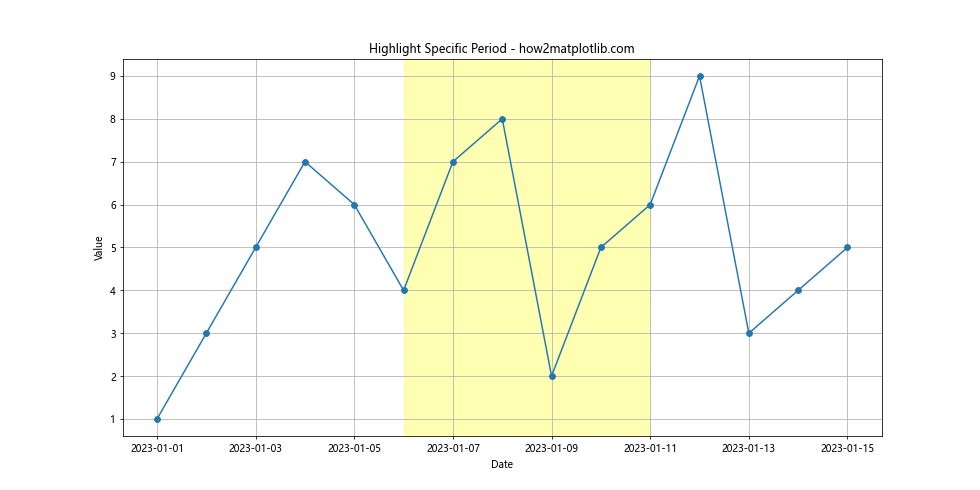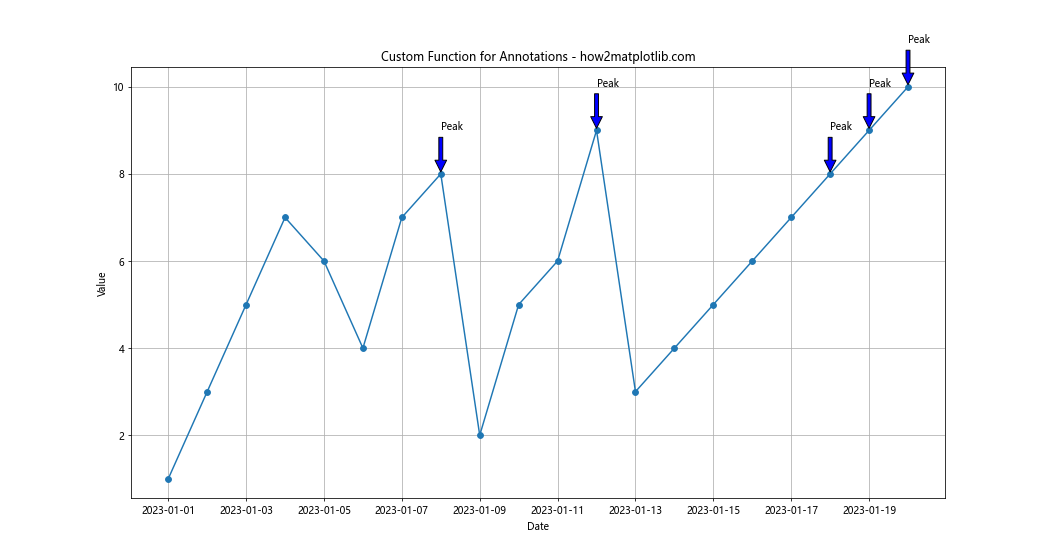Annotate Time Series Plot in Matplotlib
Annotating time series plots in Matplotlib involves highlighting specific points or areas on the plot to provide additional information. This can help in making the data more understandable and insightful, especially when dealing with complex datasets. In this article, we will explore various techniques to annotate time series plots using Matplotlib, a powerful plotting library in Python.
Introduction to Matplotlib
Matplotlib is a comprehensive library for creating static, animated, and interactive visualizations in Python. It is particularly useful for plotting time series data, which involves measurements taken at successive points in time. Before diving into the specifics of annotating time series plots, it’s essential to understand some basics of Matplotlib.
Basic Plotting
Here’s a simple example of how to create a basic time series plot in Matplotlib:
import matplotlib.pyplot as plt
import pandas as pd
# Sample data
dates = pd.date_range('20230101', periods=6)
values = [1, 3, 5, 7, 6, 4]
# Create a DataFrame
df = pd.DataFrame({'Value': values}, index=dates)
# Plotting
plt.figure(figsize=(10, 5))
plt.plot(df.index, df['Value'], marker='o')
plt.title('Basic Time Series Plot - how2matplotlib.com')
plt.xlabel('Date')
plt.ylabel('Value')
plt.grid(True)
plt.show()
Output:

Annotating Time Series Plots
Annotating involves adding text, arrows, or other markers to highlight specific aspects of the plot. This can be particularly useful in time series analysis to mark important dates, changes, or anomalies.
Simple Annotations
Here is an example of how to add a simple text annotation to a time series plot:
import matplotlib.pyplot as plt
import pandas as pd
# Sample data
dates = pd.date_range('20230101', periods=6)
values = [1, 3, 5, 7, 6, 4]
# Create a DataFrame
df = pd.DataFrame({'Value': values}, index=dates)
# Plotting
plt.figure(figsize=(10, 5))
plt.plot(df.index, df['Value'], marker='o')
plt.annotate('Peak', xy=(df.index[3], df['Value'][3]), xytext=(df.index[4], df['Value'][4]),
arrowprops=dict(facecolor='black', shrink=0.05),
)
plt.title('Simple Annotation - how2matplotlib.com')
plt.xlabel('Date')
plt.ylabel('Value')
plt.grid(True)
plt.show()
Complex Annotations
For more complex annotations, you might want to include additional text formatting or multiple annotations. Here’s an example:
import matplotlib.pyplot as plt
import pandas as pd
# Sample data
dates = pd.date_range('20230101', periods=10)
values = [1, 3, 5, 7, 6, 4, 7, 8, 2, 5]
# Create a DataFrame
df = pd.DataFrame({'Value': values}, index=dates)
# Plotting
plt.figure(figsize=(12, 6))
plt.plot(df.index, df['Value'], marker='o')
plt.annotate('Start', xy=(df.index[0], df['Value'][0]), xytext=(df.index[0], df['Value'][0] + 2),
arrowprops=dict(facecolor='green', shrink=0.05),
)
plt.annotate('End', xy=(df.index[-1], df['Value'][-1]), xytext=(df.index[-1], df['Value'][-1] + 2),
arrowprops=dict(facecolor='red', shrink=0.05),
)
plt.title('Complex Annotation - how2matplotlib.com')
plt.xlabel('Date')
plt.ylabel('Value')
plt.grid(True)
plt.show()
Highlighting Specific Time Periods
Sometimes, you may want to highlight a specific time period in your time series plot. Here’s how you can do it:
import matplotlib.pyplot as plt
import pandas as pd
# Sample data
dates = pd.date_range('20230101', periods=15)
values = [1, 3, 5, 7, 6, 4, 7, 8, 2, 5, 6, 9, 3, 4, 5]
# Create a DataFrame
df = pd.DataFrame({'Value': values}, index=dates)
# Plotting
plt.figure(figsize=(14, 7))
plt.plot(df.index, df['Value'], marker='o')
plt.axvspan(df.index[5], df.index[10], color='yellow', alpha=0.3)
plt.title('Highlight Specific Period - how2matplotlib.com')
plt.xlabel('Date')
plt.ylabel('Value')
plt.grid(True)
plt.show()
Output:

Using Custom Functions for Annotations
For more dynamic annotations, you can define custom functions to annotate multiple points based on certain conditions. Here’s an example:
import matplotlib.pyplot as plt
import pandas as pd
# Sample data
dates = pd.date_range('20230101', periods=20)
values = [1, 3, 5, 7, 6, 4, 7, 8, 2, 5, 6, 9, 3, 4, 5, 6, 7, 8, 9, 10]
# Create a DataFrame
df = pd.DataFrame({'Value': values}, index=dates)
# Custom annotation function
def annotate_peaks(ax, df):
peaks = df[df['Value'] > 7]
for date, row in peaks.iterrows():
ax.annotate('Peak', xy=(date, row['Value']), xytext=(date, row['Value'] + 1),
arrowprops=dict(facecolor='blue', shrink=0.05),
)
# Plotting
plt.figure(figsize=(15, 8))
plt.plot(df.index, df['Value'], marker='o')
annotate_peaks(plt.gca(), df)
plt.title('Custom Function for Annotations - how2matplotlib.com')
plt.xlabel('Date')
plt.ylabel('Value')
plt.grid(True)
plt.show()
Output:

Conclusion
Annotating time series plots in Matplotlib is a powerful way to enhance the visualization of your data. By using simple annotations, complex annotations, highlighting specific periods, or creating custom annotation functions, you can provide valuable insights into your data. This guide has provided several examples to help you get started with annotating your own time series plots using Matplotlib.